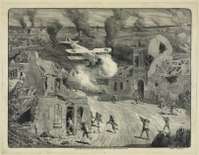Battle of Soissons (1918)
The Battle of Soissons (also known as the Battle of the Soissonnais and of the Ourcq (French: Bataille du Soissonnais et de L'Ourcq)[lower-alpha 1] was a battle during World War I, waged from 18 to 22 July 1918, between the French (with American and British assistance) and German armies.
Ferdinand Foch, the Allied Supreme Commander, launched the offensive on 18 July; 24 French divisions and 2 British[1] and 2 U.S. divisions under French command, supported by approximately 478 tanks, sought to eliminate the salient that was aimed at Paris.
The Allies suffered 107,000 casualties (95,000 French and 12,000 American), while the Germans suffered 168,000 casualties.[2]
The battle ended with the French recapturing most of the ground lost to the German Spring Offensive in May 1918.
Adolf Hitler, the future Führer of Nazi Germany, earned and was awarded the Iron Cross First Class at Soissons on August 4th 1918.

Footnote
References
- ↑ Brig-Gen Sir James E. Edmonds, History of the Great War: Military Operations, France and Belgium 1918, Vol III, May–July: The German Diversion Offensives and the First Allied Counter-Offensive, London: Macmillan, 1939/Imperial War Museum and Battery Press, 1994, ISBN 0-89839-211-X, pp. 249–54, 264–7.
- ↑ The Second Battle of the Marne, firstworldwar.com, accessed 3 September 2009
